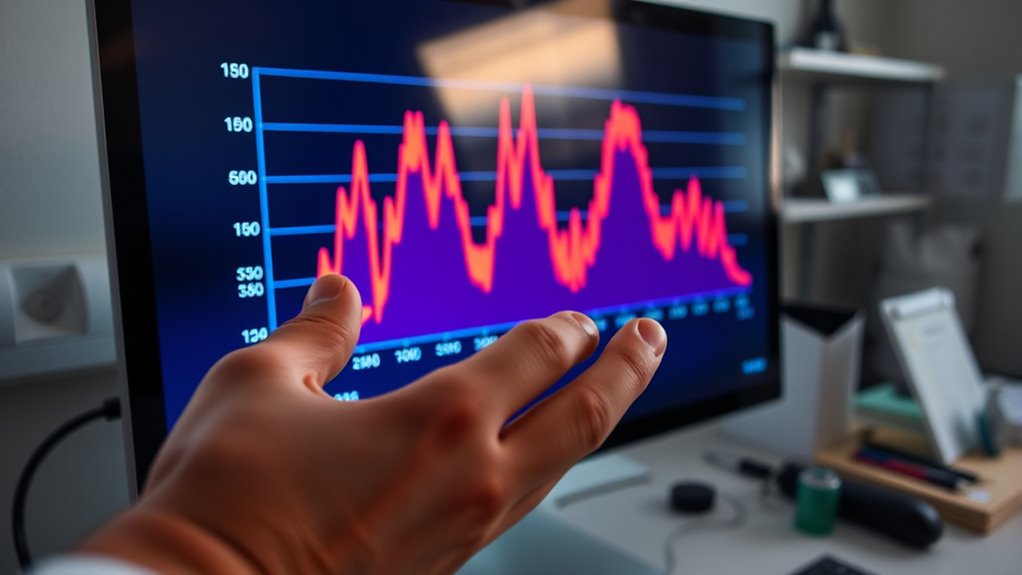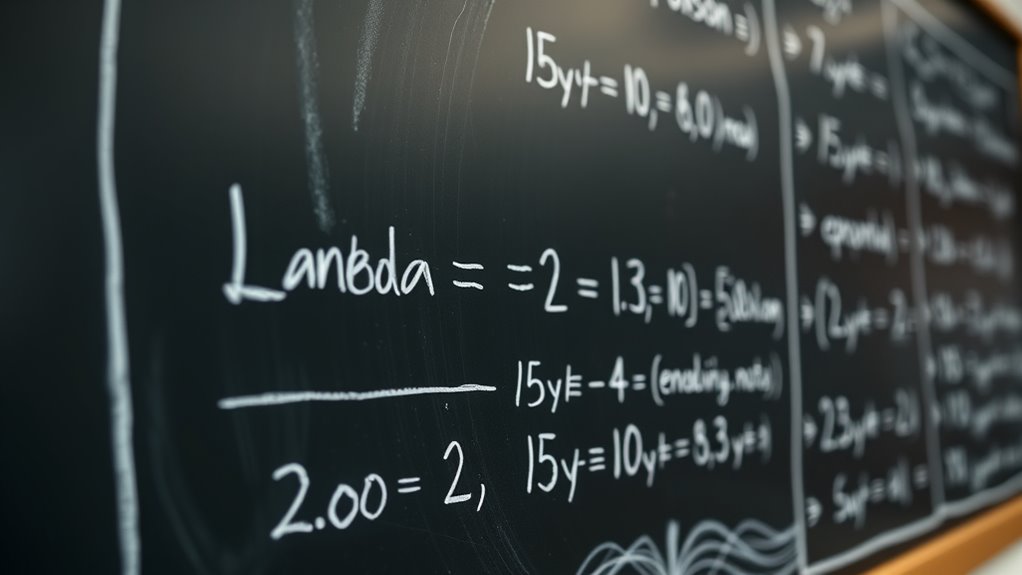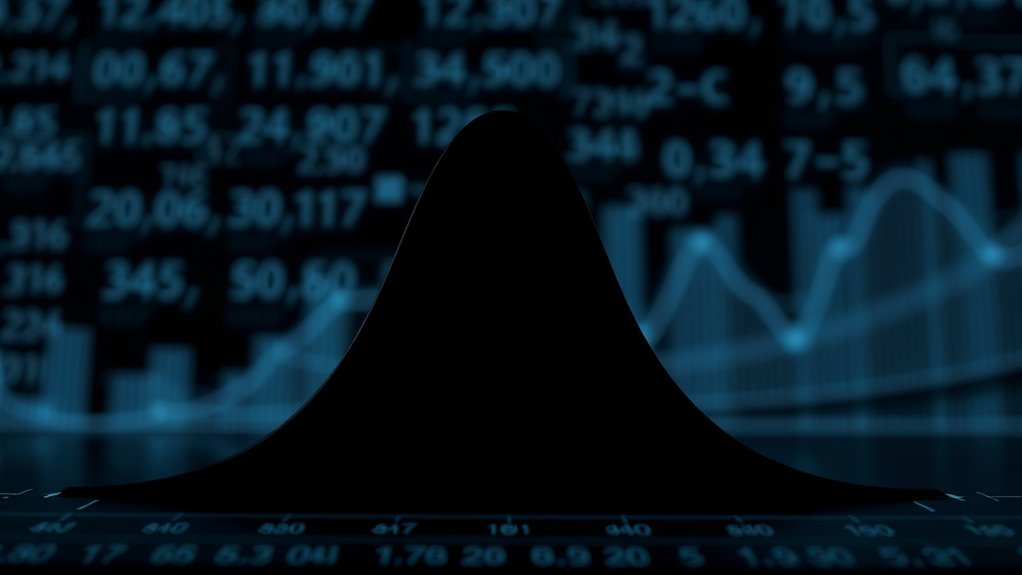A Poisson distribution helps you understand the likelihood of rare, independent events happening within a fixed interval, based on their average rate, called lambda (λ). It’s useful for counting things like customer arrivals or defects, where each event occurs randomly and independently. The distribution shows how often different numbers of events are expected to occur. If you want to explore how it works and when to use it, there’s more to discover.
Key Takeaways
- The Poisson distribution models the probability of a given number of rare, independent events occurring in a fixed interval.
- It is characterized by the average rate parameter λ, which predicts how often events happen.
- The formula for probability is P(X = k) = (λ^k e^{-λ}) / k!, where k is the number of events.
- It is used when events occur randomly and independently at a constant average rate over time or space.
- The distribution is skewed for small λ and becomes more symmetric as λ increases.
Understanding the Basics of Poisson Distribution

The Poisson distribution is a fundamental concept in probability that models how often rare, independent events occur within a fixed interval of time or space. You can think of it as a way to predict the likelihood of a certain number of events happening, based on an average rate, denoted by λ. This distribution applies when events are infrequent and happen independently, like customer arrivals or disease cases. The key is the single parameter, λ, which tells you the average count of events in the interval. Additionally, the distribution’s astrological significance can shed light on the personality traits that influence how individuals perceive and approach chance events. The probability of exactly (k) events is calculated with the formula (P(X = k) = frac{lambda^k e^{-lambda}}{k!}). It’s a versatile model for counting discrete events that occur randomly but at a consistent average rate.
Key Characteristics of Poisson Events

Understanding the key characteristics of Poisson events helps you grasp how this distribution models real-world phenomena. You’ll see that events happen within a fixed interval of time or space, and each event occurs independently of others. A new sentence with diverse design options and the rest of the sentence. The average rate of occurrences, called λ, stays constant, which means the likelihood of an event doesn’t change over the interval. Outcomes are discrete and countable, like the number of emails received per hour or defects on a product. Importantly, two events can’t happen simultaneously. When λ is small, the distribution is right-skewed; as λ increases, it becomes more symmetric, approaching a normal shape. These traits make the Poisson distribution ideal for modeling rare events and analyzing processes across various fields.
The Mathematical Formula Behind Poisson

To calculate the probability of a specific number of events occurring within a fixed interval, the Poisson distribution relies on a precise mathematical formula.
This formula is ( P(X=x) = frac{e^{-lambda} lambda^x}{x!} ), where ( e ) is Euler’s number, approximately 2.718.
The parameter ( lambda ) is the average rate of events, which also equals the mean and variance of the distribution.
The variable ( x ) represents the number of occurrences, and it can be any non-negative integer.
This formula applies when events happen independently at a constant average rate, reflecting the exponential distribution often associated with modeling waiting times between events.
It calculates the probability for each specific ( x ), with larger ( x ) values involving factorials in the denominator to account for multiple occurrences.
Understanding the expected rate of events is essential for accurate probability calculations in a Poisson distribution.
How Mean, Variance, and Shape Are Related

Have you ever wondered how the shape of a Poisson distribution relates to its mean and variance?
The shape of a Poisson distribution depends directly on its mean and variance, shaping how it appears.
In a Poisson distribution, both the mean ((lambda)) and variance are equal, which directly influences its shape. When (lambda) is small, the distribution is skewed to the right, with a peak at lower counts. This skewness is characteristic of distributions with small mean values, where the probability mass is concentrated at lower outcomes.
As (lambda) increases, it becomes more symmetric and resembles a normal distribution. This shift occurs because larger (lambda) values spread the probabilities over a wider range of outcomes, increasing variability. The increasing symmetry is a result of the distribution approaching the properties of a normal distribution, especially as the mean and variance grow larger.
The distribution’s dispersion remains consistent, with the index of dispersion always equal to 1. Additionally, the relationship between mean and variance plays a crucial role in determining the distribution’s overall shape and behavior. This relationship is fundamental in understanding how the distribution adapts as parameters change.
Ultimately, the shape change reflects the increasing mean and variance, linking the distribution’s form directly to these fundamental parameters.
When and Why to Use Poisson in Real-World Scenarios

The Poisson distribution is ideal for modeling scenarios where events happen randomly but at a predictable average rate. You should utilize it when counting discrete events within a fixed interval or space, especially if these events are rare. It works best when events occur independently, and the rate remains constant over time. For example, if you’re analyzing call volumes at a customer service center or predicting the number of earthquakes in a region, the Poisson distribution provides accurate estimates. It’s also useful in environmental science, traffic safety, and biology. By applying it, you can predict the likelihood of specific event counts, allocate resources effectively, and optimize scheduling. Always guarantee the assumptions of independence and a constant rate are met for reliable results. Additionally, understanding tableware and its cultural significance can help in designing appropriate settings for events where such statistical models are applied. Recognizing the parameters of the Poisson distribution ensures more precise modeling and interpretation of data.
Frequently Asked Questions
How Does the Poisson Distribution Differ From the Binomial Distribution?
You might wonder how the Poisson distribution differs from the binomial. The Poisson models the number of rare events in a fixed interval, using just one parameter, λ.
In contrast, the binomial counts successes over a set number of trials, with parameters n and p.
Poisson is simpler for large, rare events, while binomial suits experiments with a fixed number of independent trials, each with the same success probability.
Can the Poisson Distribution Be Applied to Non-Independent Events?
Ever wondered if you can rely on the Poisson distribution when events influence each other? The answer is no. It’s designed for independent events, where one event doesn’t affect another.
If events are dependent, the distribution’s assumptions break down, and your predictions become unreliable. So, for accurate modeling, stick to scenarios where events occur independently, like phone calls arriving randomly or defects in manufacturing, rather than dependent or correlated occurrences.
What Are Common Pitfalls When Using Poisson Approximation?
When you use a Poisson approximation, watch out for common pitfalls. You might assume events are independent and occur at a constant rate, but real data often violate these assumptions.
Overdispersion, where variance exceeds the mean, can lead to inaccurate results. Zero inflation and interdependence also pose challenges.
To improve accuracy, consider alternative models like the negative binomial or zero-inflated models, especially when data deviate from Poisson assumptions.
How Do Small Sample Sizes Affect Poisson Distribution Accuracy?
Small sample sizes make it harder for you to accurately estimate the Poisson distribution’s parameter, λ. This leads to unreliable predictions of event counts, increasing bias and reducing statistical power.
You might also struggle with detecting true effects or differences.
To improve accuracy, consider using mixed models or Bayesian methods that incorporate prior knowledge, helping to counteract the limitations of limited data.
Is the Poisson Distribution Suitable for Modeling Rare Events?
You’ll find that the Poisson distribution is perfect for modeling rare events because it focuses on counting how often they happen in a fixed interval. It assumes these events occur independently at a constant average rate, making it reliable for low-frequency occurrences like system failures or natural disasters.
If your events are discrete, rare, and independent, then the Poisson distribution is a suitable choice for your analysis.
Conclusion
Now that you understand the Poisson distribution, you see how it helps predict rare events accurately. Did you know that the average number of emails you receive daily can follow this distribution? It’s fascinating how such a simple model captures real-world randomness. By applying Poisson, you can make smarter decisions in fields like healthcare, finance, or traffic management. Keep exploring, and you’ll find even more surprises in the world of probability!










